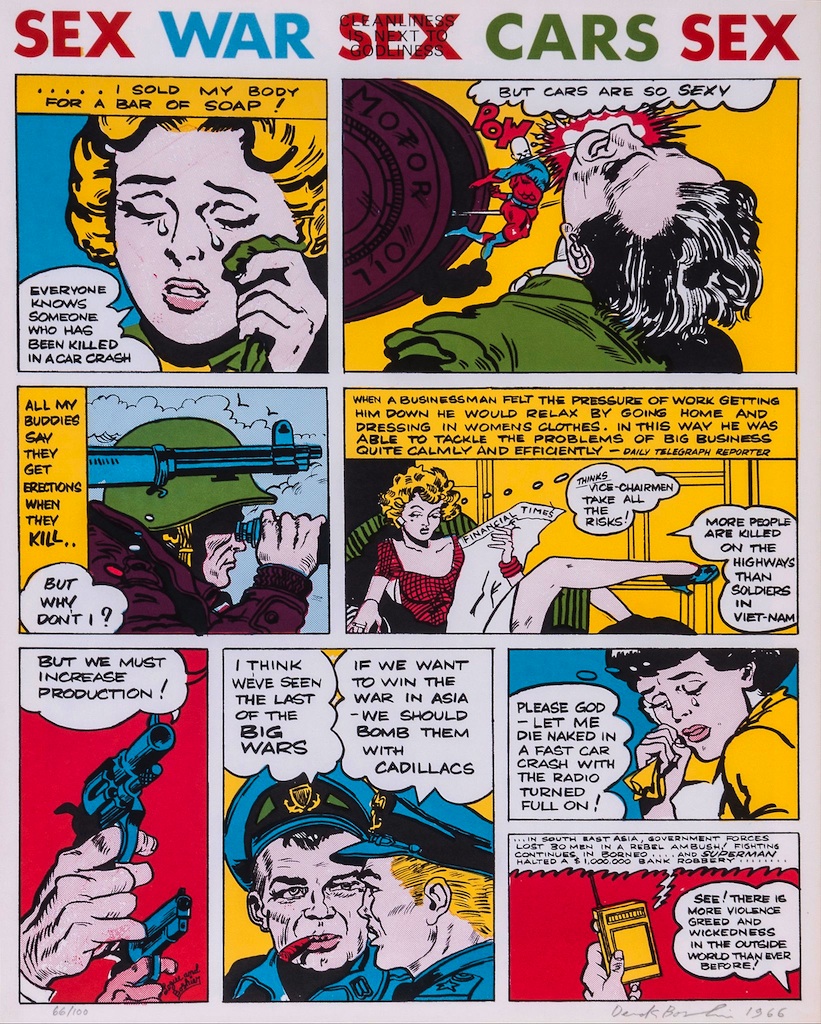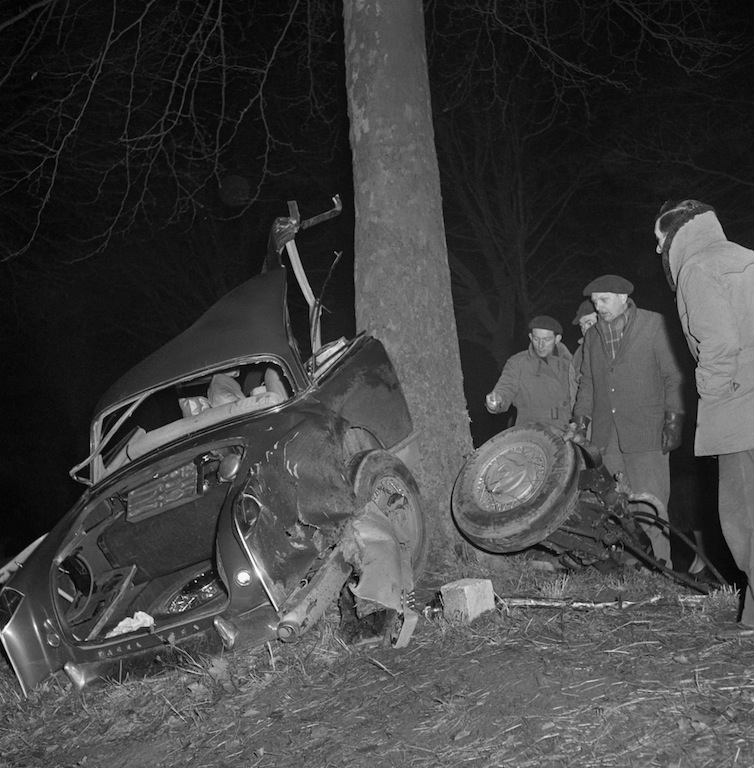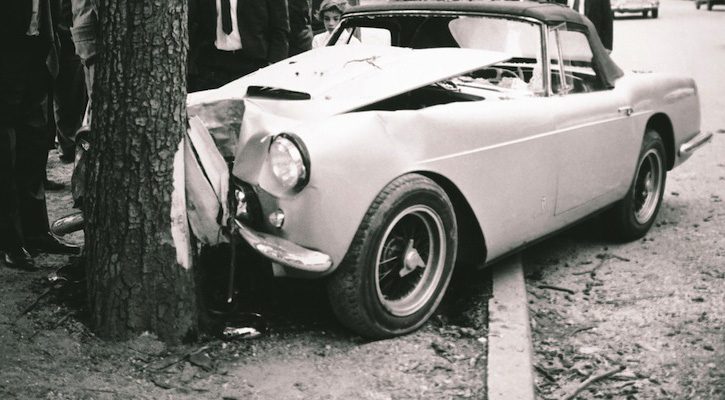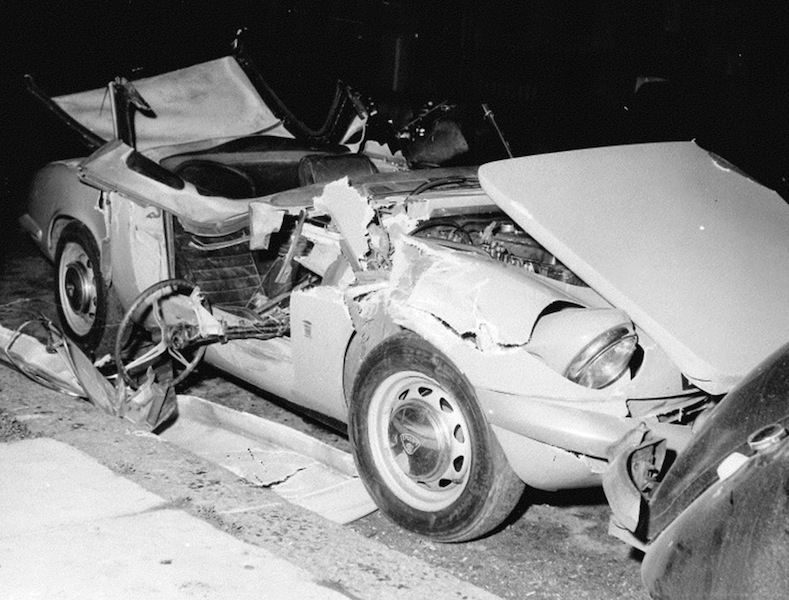Decorously illustrated with pictures of roadside wrecks, Death Drive: There Are No Accidents, published by Circa Press, a new design imprint in London, is as handsome as the subject is unsavory. In retrospect, its dark seed is present in an early Bayley book, Sex, Drink and Fast Cars (1986), where he shows a picture of James Dean’s crumpled Porsche Spyder and riffs on car crashes for a page or two. He produced a monograph about American tailfin maestro Harley Earl, and then, in 2008, came Cars: Freedom Style Sex Power Motion Colour Everything—“the book I have always wanted to write.”
Bayley might have called it quits there, but in Death Drive he feels the need to add a mournful coda. Despite his besottedness with the car—“No other manufactured object has the same disturbing allure”—even Bayley can see that the great age of internal combustion is over, and the car’s allure as status symbol and emblem of romance and freedom is fading. In the UK, where he writes, the roads are clogged. In a survey of the under thirties, he reports, not a single car maker was selected as a “cool brand.” The book’s final image is a graveyard of tangled autos.

Sex War Sex Cars Sex, a poster-poem by Derek Boshier and Christopher Logue, 1966
Death Drive is structured as a series of portraits of twenty figures in the public eye, who all died as a result of car crashes. Most of the really famous endings are here—Dean, Jackson Pollock, Jayne Mansfield, Albert Camus, Princess Grace—along with lesser-known fatalities such as the writer Nathanael West, singer Eddie Cochran, and playboy Porfirio Rubirosa. Bayley’s criteria for inclusion are sketchy, but aside from a “pattern of elegy and absurdity” in these sorry tales, car design snobbery appears to play a part. Having the poor taste to expire in a “drear Chrysler Voyager” (Grand Prix driver Clay Regazzoni) or a “dull Peugeot” (writer W. G. Sebald) can be quite enough to warrant exclusion. Princess Diana, probably the most famous crash victim of all, is out in the cold because she was “simply a passenger,” but so were Camus and Cochran. Bayley must have other unstated reasons.
What he relishes most are personal histories where style, money, class, glamour, sex, and driving like an idiot at life-endangering speed converge. If the crash victim is a racing driver, so much the better. Giuseppe Farina, the first Formula One world champion in 1950, was an “aristocratic racer,” in Bayley’s estimation, who always competed with “impeccable, patrician style,” though his reputation was eclipsed by other drivers. Famously ruthless behind the wheel, Farina was in a series of fatal accidents, almost like rehearsals—seven spectators died when he crashed into the crowd at the 1953 Argentine Grand Prix—before he lost control of a Ford Cortina Lotus while driving in the Alps, and terminated his own existence.
Bayley favors the idea that these lives have arcs that lead, as though inexorably, to their spectacularly violent endpoints. In the words of his subtitle, “There are no accidents.” In the introduction, he quotes a line by J.G. Ballard: “Deep assignments run through all our lives. There are no coincidences.” This is questionable at best, since it implies that everything happens for a larger purpose, and this purpose is somehow determined by our own impulses. Bayley repeats the Ballard line in his chapter on Camus, where the thesis is even less fruitful. The horror of the writer’s avoidable death resides in the way it fulfilled his philosophical conviction that life is absurd and meaningless. He already had a train ticket for the 500-mile journey to Paris, and only agreed to travel by car under pressure from his publisher, Michel Gallimard, who drove the luxurious Facel Vega, and also lost his life. According to a witness, the vehicle was traveling at about 90mph, a ridiculous speed on an ordinary road. Meanwhile, Camus’ wife arrived safely by train.

Albert Camus, writer, Facel Vega HK500, Petit Villeblevin, 1960

Porfirio Rubirosa, playboy, Ferrari 250 GT, Paris, 1965

Tara Browne, Guinness heir, Lotus Elan, London, 1966
Bayley has a heat-seeking eye for salient detail, as you might expect from one of our finest design pundits, and he is never more entertaining than when he is outlining the love life of a jet-setter whose membrum virile (the author’s term) was likened by admirers to an outsized pepper mill, or explaining how, in the Cadillac 75, a “Syncro-Flex” flywheel was connected to a formidable 346 cubic inch L-head V-8. It means nothing to me, but it sounds mighty impressive. Was Prince Aly Khan practicing ancient Persian breathing techniques for coitus when his Lancia Flamina smashed into a Simca Aronde? Only Bayley would think to ask. I was just noticing how Death Drive is a kind of car lover’s take on Kenneth Anger’s muckraking Hollywood Babylon when Bayley namechecked the book himself.
On its own highly personal terms, simply by telling these sometimes salacious stories, the book is a useful addition to car crash studies. What it lacks is anything more than the most rudimentary attempt at a cultural theory of the crash. Bayley takes his title from Freud’s concept of the “death drive,” which is counterposed to “the pleasure principle,” but then says almost nothing about the theory. He doesn’t want the book to be macabre, which it can hardly avoid, but that pre-emptive expression of delicacy sounds like a reluctance to confront head-on the dismaying, destabilizing reality of the crash site, and what it might mean. Bayley scrutinizes everything up to the instant the car spins out of control, including much that is immaterial, and then looks away. He refers fleetingly to a few telling examples of cultural works that deal with the image of the car crash, such as the poster-poem shown above, but doesn’t mention Warhol’s silkscreens of car wrecks, Godard’s Weekend, the academic teaching a car crash seminar in Don DeLillo’s White Noise, or Ricarda Vidal’s Death and Desire in Car Crash Culture (2013). There are plenty more.
For Bayley, the crash appears, more than anything, to be a tragedy of lacerated style, and a premonition—for him an intolerable thought—of the demise of the car.
See also:
The Experiential Thrill of Driving in Films
It’s Smart to Use a Crash Test Dummy
Crashed Car by Arnold Odermatt

